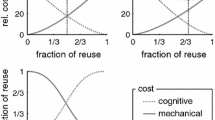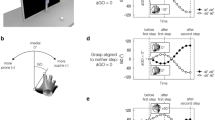Abstract
Humans grasp objects in a way that facilitates the intended use of the object. We examined how humans grasp a circular control knob in order to turn it in different directions and by different extents. To examine the processes involved in anticipatory planning of grasps, we manipulated advance information about the location of the control knob and the target of the knob-turn. The forearm orientation at the time of grasping depended strongly on the knob-turn, with the direction of the knob-turn having a stronger effect than the extent of the knob-turn. However, the variability of the forearm orientations after the knob-turn remained considerable. Anticipatory forearm orientations began early during the grasping movement. Advance information had no influence on the trajectory of the grasp but affected reaction times and the duration of the grasp. From the results, we conclude that (1) grasps are selected in anticipation of the upcoming knob rotation, (2) the desired hand location and forearm orientation at the time of grasping are specified before the onset of the grasp, and (3) an online programming strategy is used to schedule the preparation of the knob-turn during the execution of the grasp.


Similar content being viewed by others
Notes
More than one exclusion criterion may apply to each trial.
If the assumption of sphericity was violated as indicated by Mauchly's Test of Sphericity, dfs were Greenhouse-Geisser-corrected. For the sake of clarity, we report uncorrected dfs.
We do not report the main effect of knob because fast hand movements in different directions during grasping systematically distorted the supination readings of the accelerometer.
We inferred the finger movements from the movements of the control knobs because finger movements have not been directly recorded.
References
Adam JJ, Nieuwenstein JH, Huys R, Paas FG, Kingma H, Willems P, Werry M (2000) Control of rapid aimed hand movements: the one-target advantage. J Exp Psychol Hum Percept Perform 26(1):295–312
Aflalo TN, Graziano MSA (2006) Partial tuning of motor cortex neurons to final posture in a free-moving paradigm. Proc Natl Acad Sci 8:2909–2914
Brenner JB, Smeets E (1993) A new view on grasping 3(3):237–271
Butz MV, Herbort O, Hoffmann J (2007) Exploiting redundancy for flexible behavior: unsupervised learning in a modular sensorimotor control architecture. Psychol Rev 114(4):1015–1046
Chamberlin CJ, Magill RA (1989) Preparation and control of rapid, multisegmented responses in simple and choice environments. Res Q Exerc Sport 60(3):256–267
Coren S (1993) The lateral preference inventory for measurement of handedness, footedness, eyedness, and earedness: norms for young adults. Bull Psychon Soc 31:1–3
Desmurget M, Prablanc C, Arzi M, Rossetti Y, Paulignan Y, Urquizar C (1996) Integrated control of hand transport and orientation during prehension movements. Exp Brain Res 110:265–278
Eliasson A-C, Forssberg H, Ikuta K, Apel I, Westling G, Johansson R (1995) Development of human precision grip: V. anticipatory and triggered grip actions during sudden loading. Exp Brain Res 106:425–433
Elsinger CL, Rosenbaum DA (2003) End posture selection in manual positioning: evidence for feedforward modeling based on a movement choice method. Exp Brain Res 152(4):499–509
Fan J, He J, Helms Tillery S (2006) Control of hand orientation and arm movement during reach and grasp. Exp Brain Res 171(3):283–296
Favilla M (1997) Reaching movements: concurrency of continuous and discrete programming. NeuroReport 8:3973–3977
Fischer MH, Rosenbaum DA, Vaughan J (1997) Speed and sequential effects in reaching. J Exp Psychol Hum Percept Perform 23(2):404–428
Flanagan JR, Tresilian J, Wing AM (1993) Coupling of grip force and load force during arm movements with grasped objects. Neurosci Lett 152:53–56
Gentilucci M, Negrotti A, Gangitano M (1997) Planning an action. Exp Brain Res 115:116–128
Haggard P (1998) Planning of action sequences. Act Psychol 99(2):201–215
Herbort O, Butz MV (2007) Encoding complete body models enables task dependent optimal control. Proc Int Jt Conf Neural Netw 20:1639–1644
Johnson-Frey SH, McCarty ME, Keen R (2004) Reaching beyond spatial perception: Effects of intended future actions on visually guided prehension. Vis Cogn 11(2–3):371–399
Kunde W, Weigelt M (2005) Goal congruency in bimanual object manipulation. J Exp Psychol Human Percep Perform 31(1):145–156
Loukopoulos LD, Engelbrecht SF, Berthier NE (2001) Planning of reach-and-grasp movements: effects of validity and type of object information. J Mot Behav 33(3):255–264
Mackrous I, Proteau L (2007) Specificity of practice results from differences in movement planning strategies. Exp Brain Res 183(2):181–193
Marotta JJ, Medendorp WP, Crawford JD (2003) Kinematic rules for upper and lower arm contributions to grasp orientation. J Neurophysiol 90:3816–3820
Marteniuk RG, Mackenzie CL, Jeannerod M, Athenes S, Dugas C (1987) Constraints on human arm movement trajectories. Can J Psychol 41(3):365–378
Mechsner F, Kerzel D, Knoblich G, Prinz W (2001) Perceptual basis of bimanual coordination. Nat 414(6859):69–73
Mutsaarts M, Steenbergen B, Bekkering H (2006) Anticipatory planning deficits and task context effects in hemiparetic cerebral palsy. Exp Brain Res 172(2):151–162
Rosenbaum DA (1980) Human movement initiation: specification of arm, direction and extent. J Exp Psychol Gen 109:444–474
Rosenbaum DA, Jorgensen MJ (1992) Planning macroscopic aspects of manual control. Hum Mov Sci 11(1–2):61–69
Rosenbaum DA, Hindorff V, Munro EM (1987) Scheduling and programming of rapid finger sequences: tests and elaborations of the hierarchical editor model. J Exp Psychol Hum Percept Perform 13(2):193–203
Rosenbaum DA, Marchak F, Barnes HJ, Vaughan J, Siotta JD, Jorgensen MJ (1990) Constraints for action selection: overhand versus underhand grips. In: Jeannerod M (ed) Attention and performance Erlbaum. Hillsdale, NJ, pp 321–342
Rosenbaum DA, van Heugten CM, Caldwell GE (1996) From cognition to biomechanics and back: the end-state comfort effect and the middle-is-faster effect. Acta Psychol 94:59–85
Rosenbaum DA, Meulenbroek RGJ, Vaughan J, Jansen C (2001) Posture-based motion planning: applications to grasping. Psychol Rev 108(4):709–734
Rosenbaum DA, Vaughan J, Meulenbroek RGJ, Jax S, Cohen R (2009) Smart moves: the psychology of everyday perceptual-motor acts. In: Morsella E, Bargh JA, Gollwitzer PM (eds) Oxford handbook of human action. Oxford University Press, New York, pp 121–135
Short MW, Cauraugh JH (1999) Precision hypothesis and the end-state comfort effect. Acta Psychol 100(3):243–252
Steenbergen B, Hulstijn W, Dortmans S (2000) Constraints on grip selection in cerebral palsy: minimising discomfort. Exp Brain Res 134:385–397
Todorov E (2004) Optimality principles in sensorimotor control. Nat Rev Neurosci 7(9):907–915
Weigelt M, Kunde W, Prinz W (2006) End-state comfort in bimanual object manipulation. Exp Psychol 53(2):143–148
Wing AM, Lederman SJ (1998) Anticipating load torques produced by voluntary movements. J Exp Psychol 24(6):1571–1581
Zhang W, Rosenbaum DA (2008) Planning for manual positioning: the end-state comfort effect for manual abduction-adduction. Exp Brain Res 184:383–389
Acknowledgments
The authors acknowledge funding from the Emmy Noether program of the German Research Foundation (grant BU1335/3-1) and thank Georg Schüssler for technical support.
Author information
Authors and Affiliations
Corresponding author
Electronic supplementary material
Below is the link to the electronic supplementary material.
Rights and permissions
About this article
Cite this article
Herbort, O., Butz, M.V. Planning and control of hand orientation in grasping movements. Exp Brain Res 202, 867–878 (2010). https://doi.org/10.1007/s00221-010-2191-9
Received:
Accepted:
Published:
Issue Date:
DOI: https://doi.org/10.1007/s00221-010-2191-9




